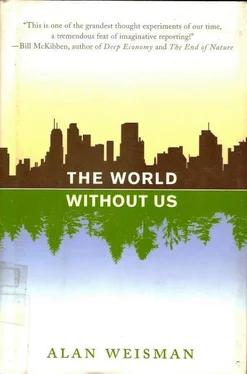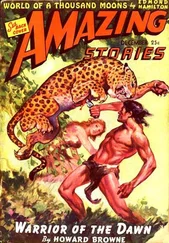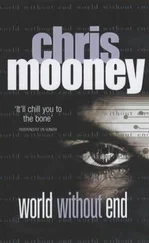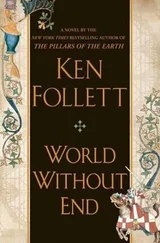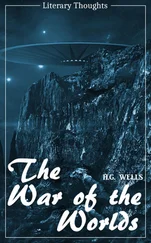After the ice recedes, buried in the moraine and eventually in geologic layers below will be an unnatural concentration of a reddish metal, which briefly had assumed the form of wiring and plumbing. Then it was hauled to the dump and returned to the Earth. The next toolmaker to arrive or evolve on this planet might discover and use it, but by then there would be nothing to indicate that it was us who put it there.
CHAPTER 4

The World Just Before Us
1. An Interglacial Interlude
FOR MORE THAN 1 billion years, sheets of ice have been sliding back and forth from the poles, sometimes actually meeting at the equator. The reasons involve continental drift, the Earth’s mildly eccentric orbit, its wobbly axis, and swings in atmospheric carbon dioxide. For the last few million years, with the continents basically where we find them today, ice ages have recurred fairly regularly and lasted upwards of 100,000 years, with intervening thaws averaging 12,000 to 28,000 years.
The last glacier left New York 11,000 years ago. Under normal conditions, the next to flatten Manhattan would be due any day now, though there’s growing doubt that it will arrive on schedule. Many scientists now guess that the current intermission before the next frigid act will last a lot longer, because we’ve managed to postpone the inevitable by stuffing our atmospheric quilt with extra insulation. Comparisons to ancient bubbles in Antarctic ice cores reveal there’s more CO 2floating around today than at any time in the past 650,000 years. If people cease to exist tomorrow and we never send another carbon-bearing molecule skyward, what we’ve already set in motion must still play itself out.
That won’t happen quickly by our standards, although our standards are changing, because we Homo sapiens didn’t bother to wait until fossilization to enter geologic time. By becoming a veritable force of nature, we’ve already done so. Among the human-crafted artifacts that will last the longest after we’re gone is our redesigned atmosphere. Thus, Tyler Volk finds nothing strange about being an architect teaching atmospheric physics and marine chemistry on the New York University biology faculty. He finds he must draw on all those disciplines to describe how humans have turned the atmosphere, biosphere, and the briny deep into something that, until now, only volcanoes and colliding continental plates have been able to achieve.
Volk is a lanky man with wavy dark hair and eyes that scrunch into crescents when he ponders. Leaning back in his chair, he studies a poster that nearly fills his office bulletin board. It portrays atmosphere and oceans as a single fluid with layers of deepening density. Until about 200 years ago, carbon dioxide from the gaseous part above dissolved into the liquid part below at a steady rate that kept the world at equilibrium. Now, with atmospheric CO 2levels so high, the ocean needs to readjust. But because it’s so big, he says, that takes time.
“Say there are no more people burning fuel. At first, the ocean’s surface will absorb CO 2rapidly. As it saturates, that slows. It loses some CO 2to photosynthesizing organisms. Slowly, as the seas mix, it sinks, and ancient, unsaturated water rises from the depths to replace it.”
It takes 1,000 years for the ocean to completely turn over, but that doesn’t bring the Earth back to pre-industrial purity. Ocean and atmosphere are more in balance with each other, but both are still supercharged with CO 2. So is the land, where excess carbon will cycle through soil and life-forms that absorb but eventually release it. So where can it go? “Normally,” says Volk, “the biosphere is like an upside-down glass jar: On top, it’s basically closed to any extra matter, except for letting in a few meteors. At the bottom, the lid is slightly open—to volcanoes.”
The problem is, by tapping the Carboniferous Formation and spewing it up into the sky, we’ve become a volcano that hasn’t stopped erupting since the 1700s.
So next, the Earth must do what it always does when volcanoes throw extra carbon into the system. “The rock cycle kicks in. But it’s much longer.” Silicates such as feldspar and quartz, which comprise most of the Earth’s crust, are gradually weathered by carbonic acid formed by rain and carbon dioxide, and turn to carbonates. Carbonic acid dissolves soil and minerals that release calcium to groundwater. Rivers carry this to the sea, where it precipitates out as seashells. It’s a slow process, sped slightly by the intensified weather in the supercharged atmosphere.
“Eventually,” Volk concludes, “the geologic cycle will take CO 2back to prehuman levels. That will take about 100,000 years.”
Or longer: One concern is that even as tiny sea creatures are locking carbon up in their armor, increased CO 2in the oceans’ upper layers may be dissolving their shells. Another is that the more oceans warm, the less CO 2they absorb, as higher temperatures inhibit growth of CO 2-breathing plankton. Still, Volk believes, with us gone the oceans’ initial 1,000-year turnover could absorb as much as 90 percent of the excess carbon dioxide, leaving the atmosphere with only about 10 to 20 extra parts per million of CO 2above the 280 ppm preindustrial levels.
The difference between that and today’s 380 ppm, scientists who’ve spent a decade coring the Antarctic ice assure us, means that there will be no encroaching glaciers for at least the next 15,000 years. During the time that the extra carbon is being slowly sopped up, however, palmettos and magnolias may be repopulating New York City faster than oaks and beeches. The moose may have to seek gooseberries and elderberries in Labrador, while Manhattan instead hosts the likes of armadillos and peccaries advancing from the south…
…unless, respond some equally eminent scientists who’ve been eying the Arctic, fresh meltwater from Greenland’s ice cap chills the Gulf Stream to a halt, closing down the great ocean conveyor belt that circulates warm water around the globe. That would bring an ice age back to Europe and the East Coast of North America after all. Maybe not severe enough to trigger massive sheet glaciers, but treeless tundra and permafrost could become the alternative to temperate forest. The berry bushes would be reduced to stunted, colorful spots of ground cover among the reindeer lichen, attracting caribou southward.
In a third, wishful scenario, the two extremes might blunt each other enough to hold temperatures suspended in between. Whichever it is, hot or cold or betwixt, in a world where humans stayed around and pushed atmospheric carbon to 500 or 600 parts per million—or the projected 900 ppm by AD 2100, if we change nothing from the way we do business today—much of what once lay frozen atop Greenland will be sloshing in a swollen Atlantic. Depending on exactly how much of it and Antarctica go, Manhattan might become no more than a few islets, one where the Great Hill once rose above Central Park, another an outcropping of schist in Washington Heights. For a while, clutches of buildings a few miles to the south would vainly scan the surrounding waters like surfacing periscopes, until buffeting waves brought them down.
Had humans never evolved, how might the planet have fared? Or was it inevitable that we did?
And if we disappeared, would—or could—we, or something equally complicated, happen again?

FAR FROM EITHER pole, East Africa’s Lake Tanganyika lies in a crack that, 15 million years ago, began to split Africa in two. The Great African Rift Valley is the continuation of a tectonic parting of the ways that began even earlier in what is now Lebanon’s Beqaa Valley, then ran south to form the course of the Jordan River and the Dead Sea. Then it widened into the Red Sea, and is now branching down two parallel cleavages through the crust of Africa. Lake Tanganyika fills the Rift’s western fork for 420 miles, making it the longest lake in the world.
Читать дальше
